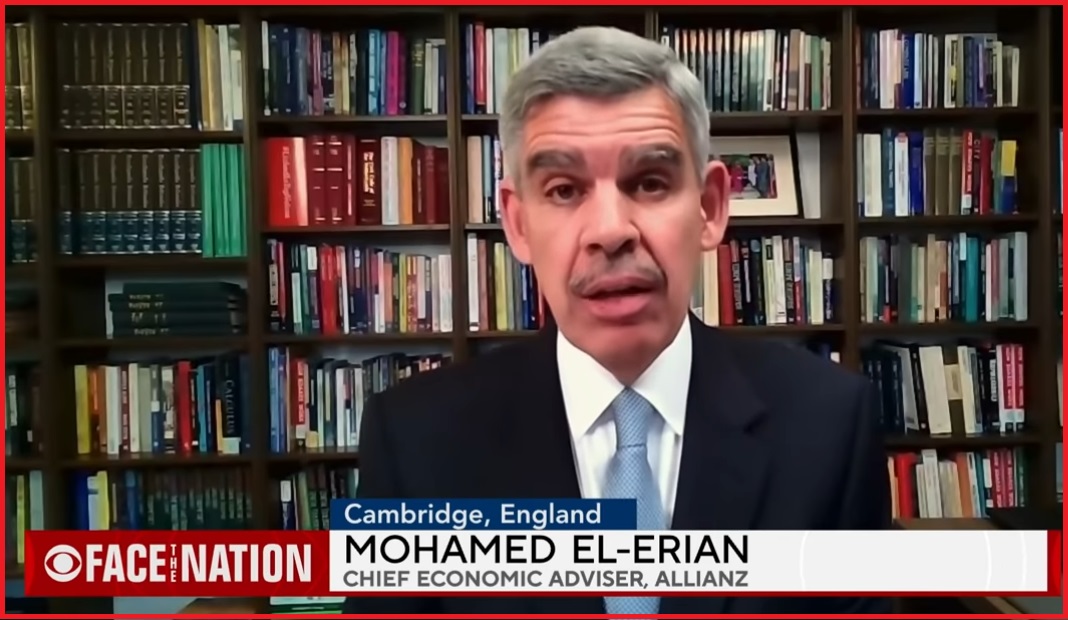Sunday Talks, El Erian Predicts, Accurately, Inflation To Climb Beyond Ten Percent This Year
Mohamed El-Erian, the chief economic adviser for Allianz, got the inflation problem correct; states a forecast in line with CTH Main Street review, but then falls short on his political outlook for the solution.
Within the interview, El-Erian predicts inflation at the current CPI measure will increase from current 7.9% to over 10% this year. That aspect is in alignment with CTH review at ground level.
Current real inflation is more than 15% across the board, if you use the CPI methodology we were using in the 70’s and 80’s. Both the scale and the speed of the current price increases are historic. That is why you are seeing prices on retail items jumping so high, so fast. The price increases on highly consumable goods are in the 15 to 20% range. WATCH:
An increase to over 10%, using current CPI measures, equals an increase of 25 to 30% in actual price (using historic measures). Keep in mind, we have already passed through a wave of backward-looking inflation in the 25 to 30% range. El-Erian is predicting a duplication of that scale into the remainder of 2022, I agree. The 2020 $3 item became the 2021 $4 item, which will now become the 2022 $5.50 item. That is our reality. It will not get better.
Where we differ from El-Erian is on the wage side and the political analysis. Any political intervention to create govt subsidy with the goal to generate a higher workforce will backfire – bigly. Recent historic employment statistics have not yet reflected the demand side decline in goods. The employment data is skewed and useless because of the COVID mitigation impact on jobs.
The employment picture is only just now starting to reflect the demand side drop. Wages will not grow and will not provide fuel for inflation. The currently hidden workforce reductions are generating downward pressure on wages naturally. Adding subsidies (childcare etc), to generate a higher workforce into an environment with declining available jobs, will backfire.
Sector specific unions negotiating for higher wage contracts will find themselves trying to get wage increases while the top line of the organization is dropping due to lack of demand. Unfortunately, the AFSCME is generally immune to this problem – government spending can always expand.
This is where El-Erian’s connection to Wall Street is his blind spot. If what he suggests were carried out, govt will print money to cover even more deficit spending (the BBB agenda). That increased money supply will create even more inflation at the same time real life wage pressures are going down because the economy is contracting, and workers are getting laid-off.
The economy, quantified by the goods/services generated (minus imports), has been contracting since mid 2021. The govt COVID subsidies created artificial and unnatural demand for goods. If you take the massive COVID expenditures ($5+ trillion) out of the 2021 economy, the result is a recession that began mid 2021.
That bloated chicken, which carried the inflation created by the printing, is coming home to roost. There ain’t no way in hell to avoid it. The recession exists, regardless of our desire to ignore it or fill the hole with more QE printing.
The inflation problem is now magnified by the need for the Fed to raise interest rates and stop purchasing our own debt. Raising interest rates will lower investment and naturally create fewer jobs. The economy will contract further and faster. El-Erian accurately notes there is no positive way out of this scenario, there are bad options and worse options. The difference between them is how slow or fast we want to take off the bandaid.
$3 – $4 bread in 2020, became $4 – $5 bread in 2021, which will become $5.50 – $6.50 bread mid-summer 2022. Other food store averages will follow a similar rate of price increase. The processed food inflation is settling down, however, fresh foods inflation will now take over and has only just begun. Fresh fruits and vegetables will increase in price at roughly twice the rate of processed goods.
Chemical product price increases should level off mid-summer; however, with unleaded gasoline still on target for $7/gal [diesel $8/$9 (range)] the packaging, transportation and distribution costs will continue putting upward pressure on finished good prices.
All of these things were going to happen this year, regardless of Russia and Ukraine. The European conflict is now just a convenient excuse to avoid blame for outcomes of the underlying policies.
This economic reality is not exclusively a U.S. issue; however, the scale of the economic problem is exclusively a U.S. issue. The globe may drop into a recession, but our hole will be far worse.





Post a Comment